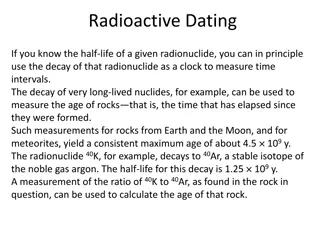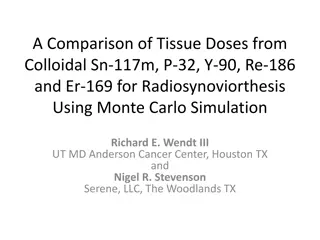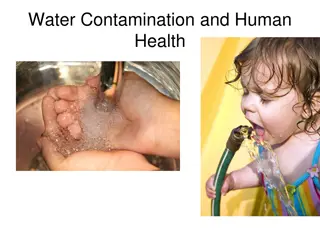Production of Radiopharmaceuticals
Radiopharmaceuticals play a crucial role in medical imaging, with a significant portion containing Tc-99m that requires chemical modification. Various Tc-labeled radiopharmaceuticals like DTPA, HIDA, MIBI, and others are used for imaging. Desirable properties of radionuclides include half-life suita
9 views • 32 slides
Gas-Filled Detector Operation and Use in Nuclear Medicine
Gas-filled detectors play a crucial role in nuclear medicine applications. This lecture delves into the operation of a dose calibrator, explaining the radionuclide buttons' functionality and how to determine the appropriate activity of various radionuclides. It also covers the use of ionization surv
1 views • 16 slides
Radioactive Dating Methods
The process of radioactive dating involves utilizing the decay of radionuclides to measure time intervals, with applications in determining the age of rocks and artifacts. Techniques such as radiocarbon dating, based on isotopes like 14C, enable scientists to determine the age of organic materials b
0 views • 4 slides
Study on Electrochemical Dissolution of Iron Monosulfide in Nuclear Waste Disposal
Exploration of the electrochemical dissolution of iron monosulfide in the context of nuclear waste disposal, focusing on its impact on redox potential, corrosion products, and transport of radionuclides. The project aims to clarify reaction kinetics, mechanisms of sulfur release, and factors control
0 views • 13 slides
Comparison of Tissue Doses from Various Radionuclides for Radiosynoviorthesis
This study compares tissue doses from different radionuclides - Sn-117m, P-32, Y-90, Re-186, and Er-169 - for radiosynoviorthesis using Monte Carlo simulation. It explores electron range, half-life, and therapeutic absorbed doses to synovial tissues, presenting a hypothesis on the selection of radio
0 views • 12 slides
Water Contamination and Human Health: Causes, Types, and Examples
Water contamination poses a significant risk to human health, caused by various pollutants such as microorganisms, chemicals, industrial wastes, and sewage. Common sources include human and animal sewage, industrial emissions, pesticides, and agricultural runoff. Different types of contaminants incl
0 views • 25 slides





